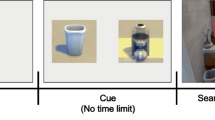Abstract
This paper focuses on the problem of scene classification for mobile robots in an outdoor environment. We present a novel model that combines biologically inspired features and cortex-like memory patterns. The biologically inspired gist feature is used to characterize the content of a scene image. The Incremental Hierarchical Discriminant Regression tree is used to simulate the generation and recall process of human memory. The association between the gist feature and the scene label is established in an incremental way. A cognitive model of the world is constructed using real-time online learning, and a new scene differentiated by reasoning. Using the biologically motivated model, we solved the outdoor scene classification problem on the University of Southern California data set. Experimental results indicate the incremental model improves the classification accuracy rates to nearly 100 % and significantly reduces training costs compared with other biologically inspired feature-based approaches. The new scene classification system achieves state-of-the-art performance.








Similar content being viewed by others
References
Fox D, Burgard W, Dellaert F, Thrun S. Monte Carlo localization: efficient position estimation for mobile robots. In: Proceedings of the 16th national conference on artificial intelligence, July 1999.
Lingemann K, Sunrnann H, Nuchter A, Hertzberg J. Indoor and outdoor localization for fast mobile robots. In: Proceedings of IEEE/RSJ international conference on intelligent robots and systems, Sept 2004, pp. 2185–2190.
Ulrich I, Nourbakhsh I. Appearance-based place recognition for topological localization. In: Proceedings of IEEE international conference on robotics and automation, Apr 2000, pp. 1023–1029.
Torralba A, Murphy KP, Freeman WT, Rubin MA. Context-based vision system for place and object recognition. In: Proceedings of IEEE international conference on computer vision (ICCV), Oct 2003, pp. 1023–1029.
Jain AK, Vailaya A. Image retrieval using color and shape. Pattern Recognit. 1996;29(8):1233–44.
Chang E, Goh K, Sychay G, Wu G. Content-based soft annotation for multimodal image retrieval using Bayes point machines. IEEE Trans Circuit Syst Video Technol. 2006;13(1):26–38.
Serrano N, Savakis A, Luo J. Improved scene classification using efficient low-level features and semantic cues. Pattern Recogn. 2004;37(9):1773–84.
Vogel J, Schiele B. Semantic modeling of natural scenes for content-based image retrieval. Int J Comput Vis. 2007;72(2):133–57.
Fan J, Gao Y, Luo H, Xu G. Statistical modeling and conceptualization of natural images. Pattern Recogn. 2005;38(6):865–85.
Bosch A, Zisserman A, Munoz X. Scene classification using a hybrid generative/discriminative approach. IEEE Trans Pattern Anal Mach Intell. 2008;30(4):712–27.
Qin J, Yung NHC. Scene categorization via contextual visual words. Pattern Recogn. 2010;43(5):1874–88.
Itti L, Koch C, Niebur E. A model of saliency-based visual attention for rapid scene analysis. IEEE Trans Pattern Anal Mach Intell. 1998;20(11):1254–9.
Itti L, Koch C. Computational modeling of visual attention. Nat Rev Neurosci. 2001;2(3):194–203.
Siagian C, Itti L. Rapid biologically-inspired scene classification using features shared with visual attention. IEEE Trans Pattern Anal Mach Intell. 2007;29(2):300–12.
Song D, Tao D. C1 units for scene classification. In: Proceedings of IEEE international conference on pattern and recognition, 2008, pp. 1–4.
Song D, Tao D. Biologically inspired feature manifold for scene classification. IEEE Trans Image Process. 2010;19(1):174–84.
Poggio T, Bizzi E. Generalization in vision and motor control. Nature. 2004;431:768–74.
Hwang WS, Weng J. Online image classification using IHDR. Int J Doc Anal Recognit. 2003;5(2–3):118–25.
Hwang WS, Weng J. Incremental hierarchical discriminant regression. IEEE Trans Neural Netw. 2007;18(2):397–415.
Weng J, McClelland J, Pentland A, Sporns O, et al. Autonomous mental development by robots and animals. Science. 2001;291(5504):599–600.
Oliva A, Schyns P. Coarse blobs or fine edges? Evidence that information diagnosticity changes the perception of complex visual stimuli. Cogn Psychol. 1997;34:72–107.
Oliva A, Schyns P. Colored diagnostic blobs mediate scene recognition. Cogn Psychol. 2000;41(2):176–210.
Serre T, Wolf L, Bileschi S, Riesenhuber M, Poggio T. Robust object recognition with cortex-like mechanisms. IEEE Trans Pattern Anal Mach Intell. 2007;29(3):411–26.
Hwang WS, Weng J. Hierarchical discriminant regression. IEEE Trans Pattern Anal Mach Intell. 2000;22(11):1277–93.
Hussain A. Cognitive computation: an introduction. Cogn Comput. 2009;1:1–3.
Squartini S, Schuller B, Hussain A. Cognitive and emotional information processing for human–machine interaction. Cogn Comput. 2012;4:383–5.
Cambria E, Hussain A. Sentic album: content-, concept-, and context-based online personal photo management system. Cogn Comput. 2012;4:477–96.
Solé-Casals J, Zaiats V. A non-linear VAD for noisy environments. Cogn Comput. 2010;2:191–8.
Solé-Casals J, Caiafa CF. A simple approximation for fast nonlinear deconvolution. In: Advances in nonlinear speech processing—5th international conference on nonlinear speech processing, 2011, pp. 55–62.
Ho-Phuouc T, Guyader N, Guerin-Dugue A. A functional and statistical bottom-up saliency model to reveal the relative contributions of low-level visual guiding factors. Cogn Comput. 2010;2:344–59.
Li J, Tian Y, Huang T, Gao W. Probabilistic multi-task learning for visual saliency estimation in video. Int J Comput Vis. 2010;90(2):150–65.
Yanulevskaya V, Marsman JB, Cornelissen F, Geusebroek J-M. An image statistics-based model for fixation prediction. Cogn Comput. 2011;3:94–104.
Cutsuridis V. A cognitive model of saliency, attention, and picture scanning. Cogn Comput. 2009;1:292–9.
Siagian C, Itti L. Biologically-inspired robotics vision Monte-Carlo localization in the outdoor environment. In: Proceedings of IEEE/RSJ international conference on intelligent robots and systems, 2007, pp. 1723–1730.
Acknowledgments
This work was supported by the National Natural Science Foundation of China (No. 61105031). Sincere gratitude from the authors go to Weng and his group for the material and code of “Incremental Hierarchical Discriminant Regression” and Itti and his group for providing the data set.
Author information
Authors and Affiliations
Corresponding author
Rights and permissions
About this article
Cite this article
Zhao, J., Du, C., Sun, H. et al. Biologically Motivated Model for Outdoor Scene Classification. Cogn Comput 7, 20–33 (2015). https://doi.org/10.1007/s12559-013-9227-y
Received:
Accepted:
Published:
Issue Date:
DOI: https://doi.org/10.1007/s12559-013-9227-y




